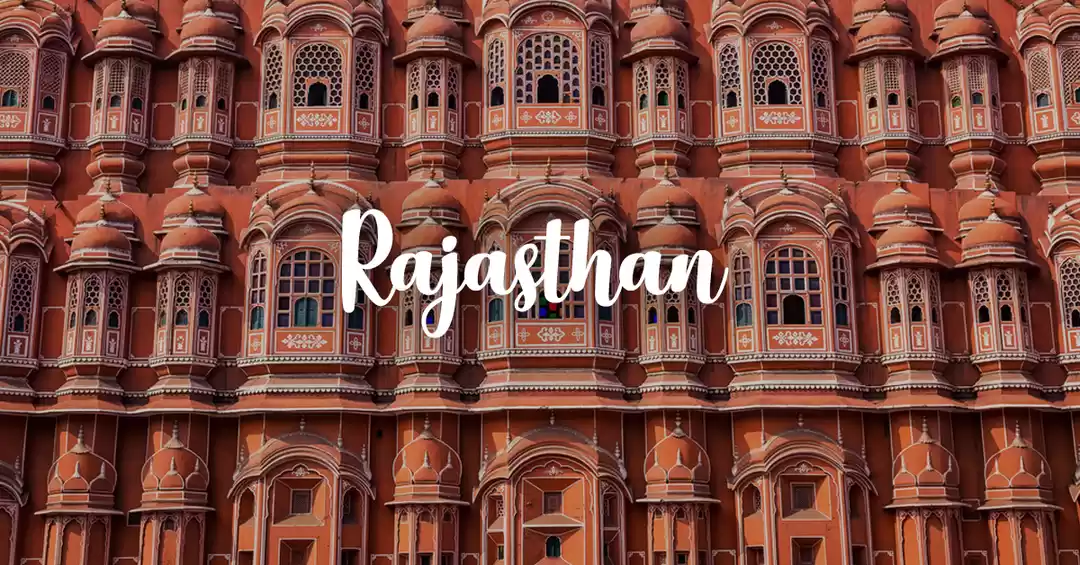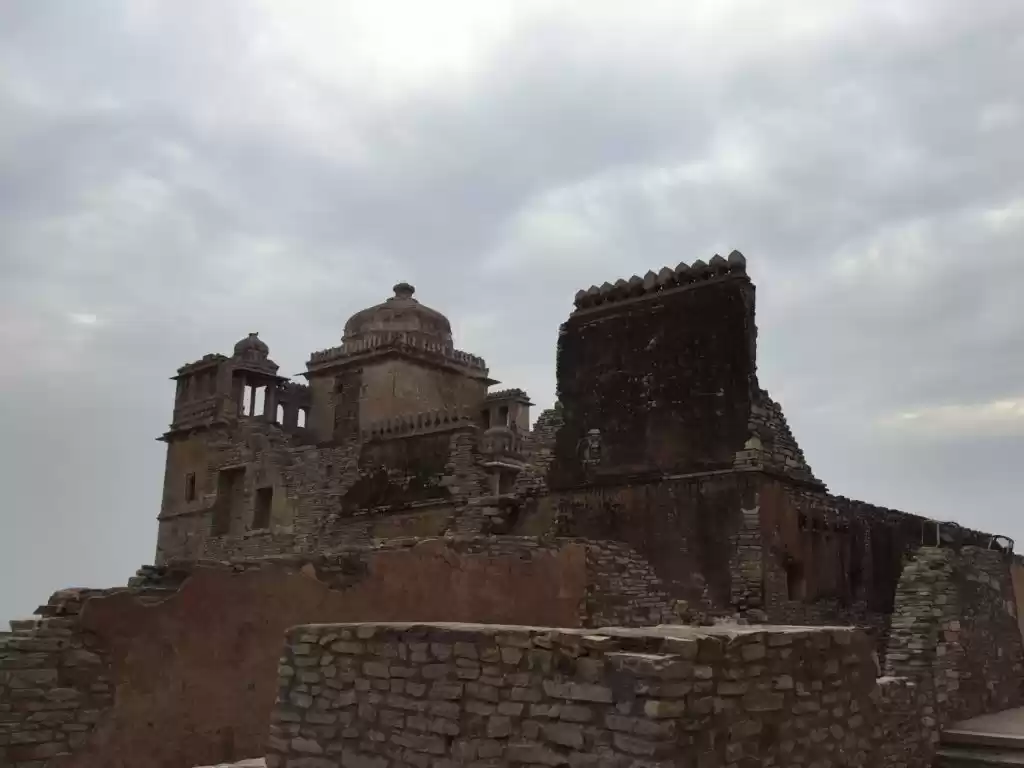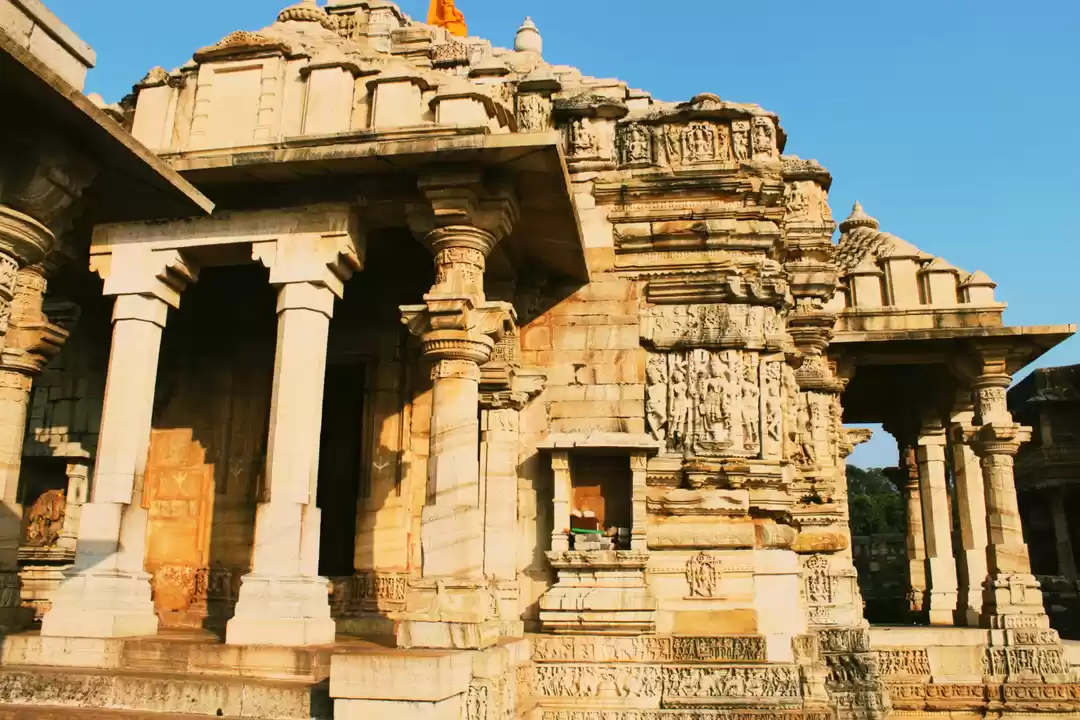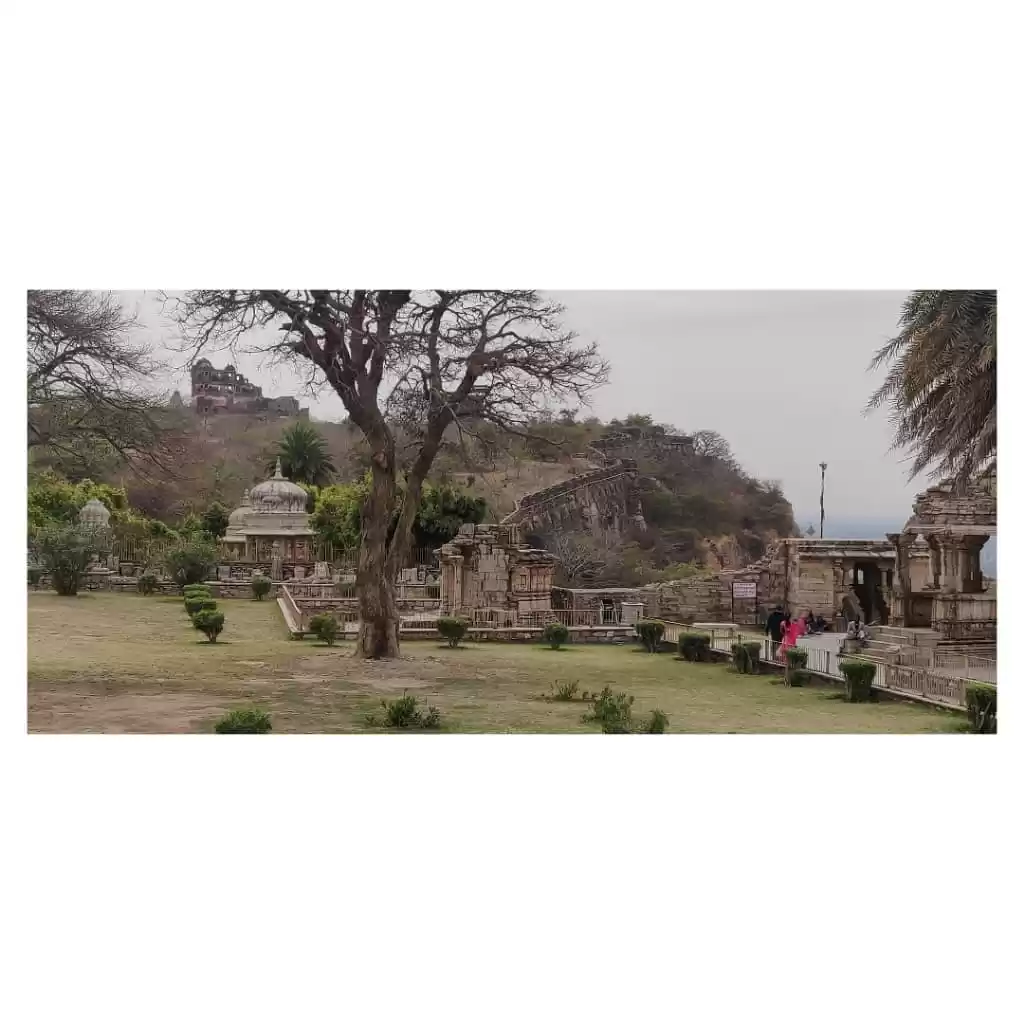




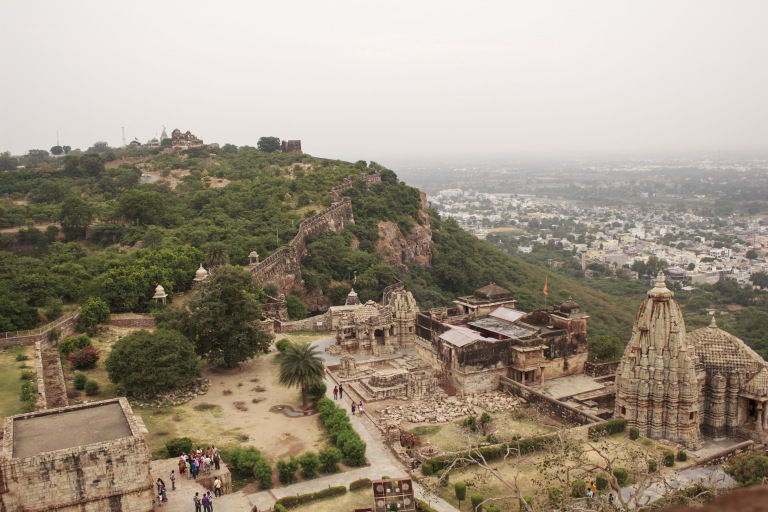










Chittorgarh Fort is built on a south-eastern plateau of the Aravallis that rises about 500 ft from ground level. The Fort covers an area of about 8 sq. km making it the largest fort in India. Built by the Mauryas between the 5th and the 8th centuries, it had been occupied by the Rajputs and rulers from Gujarat with periodic assaults by Muslim rulers. Chittorgarh was the capital of the Kingdom of Mewar till Udai Singh II shifted it to a more secure location, Udaipur, in 1559.
The Fort has also seen epic battles fought over it and has experienced 3 sieges between the 15th and 16th centuries, each one more horrific than the other. Travelling through the Fort, its many gates and winding roads, and noting its various security measures, I find it difficult to believe that the Fort was ever conquered. But history says otherwise !
In its heyday, there were about 70,000 people living within the Fort walls; today, only a fraction of that number resides in settlements scattered through the Fort. When we reach the top it is to see constructions in various states of ruin and exhibiting Hindu, Jain and Mughal architecture. While the temples appear to be in good condition, others like Rana Kumbha’s Palace, the first complex I visit, are in ruins.
During his rule (1433–1468), Rana Kumbha renovated large portions of the Fort and built new structures and added to the existing ones as well.
Though the Palace, which is believed to be the oldest structure in the Fort, is in ruins today, it is not too difficult to imagine the magnificent structure that it once must have been. As the guide points out where the Rana used to watch the sun rise and pray every morning, where the musicians used to perform, where the women’s section of the palace used to be, where the underground escape routes used to be… it is also not too difficult to travel back in time to a different era.
The next place we visit is the 15th-century Kumbhashyam Temple dedicated to Krishna. Built by Rana Kumbha in 1449, it is an exquisitely carved temple that just took my breath away. Though the guide says that the temple represents the Indo-Aryan type of architecture, I’m not sure as to what it means and he wasn’t able to elaborate either. Inside the temple walls are covered with panels depicting stories from the life of Krishna, and from the Vishnu Purana.
My next visit was to the Vijay Sthambh or the Victory Tower, again constructed by Rana Kumbha to commemorate his victory over the Sultan of Malwa in 1437. It is 9 storeys tall and intricately carved with various Hindu deities. The word “Allah” is inscribed in Arabic in the 3rd and 8th storeys.
Though one can climb all the way to the and I was all set to do so, I had to drop the idea. A 100-strong group of male tourists descended on the Vijay Sthambh just as I reached there and proceeded to completely take over the space. They ran up and down the stairs, screamed, howled, jeered and basically made a complete nuisance of themselves.
I wisely decided to forsake exploration of this intriguing structure and decided to see as much as I could through the zoom of my camera lens.
Our next halt is Rani Padmini’s Palace, which was originally built in the middle of a lotus pond. During Rani Padmini’s time, this must have been a really beautiful place, with flower gardens and a lotus filled pond. But today, the stagnant pond is foul-smelling, and the damp, moss-covered walls only makes me feel slightly nauseous. Even the existing palace is a 19th century reconstruction. But this does not seem to deter tourists as after Vijay Sthamb, this is the most visited place in Chittorgarh Fort due to the legend that surrounds Rani Padmini, the beautiful queen of Rawal Ratan Singh I, then ruler of Mewar.
Tales of her beauty travelled far and wide and reached the court of the Sultan of Delhi, Alauddin Khilji. This led to the first siege of Chittorgarh in 1303 when Khilji cut off the Fort’s food supply for 6 months. Legend has it that Khilji agreed to lift the siege if he was allowed a glimpse of Rani Padmini. This was agreed to and through a complex system of mirrors, Khilji had a glimpse of Rani Padmini from the guest room of the Men’s Palace built across the pond from Rani Padmini’s Palace.
Khilji went back on his word and demanded that Rani Padmini be handed over to him. Ratan Singh refused and a battle ensued in which 30,000 Rajputs were killed. When it was certain that Khilji would storm the Fort, Padmini and other women committed jauhar, the first of Chittorgarh’s three such events.
I can’t help wondering how the Rajputs would have even allowed an unknown man, and a Muslim at that, to have a glimpse of their queen. Wouldn’t this have been equivalent to dishonour? And isn’t death before dishonour the code for the Rajputs?
My final halt at Chittorgarh Fort is a large open clearing around which there are Hindu and Jain temples, a raised pavilion and ruins scattered about. This is the royal cremation ground. A path leads to a water tank known as the Gaumukh Kund, which was the main source of water at the Fort during the numerous sieges. An underground spring feeds water to the tank from a structure shaped like a cow’s mouth — hence, the name. The water is considered to be holy and I actually saw people removing the green scum that floated on the water’s surface to drink it.
How to Reach-
Trains: Please click the link below to download the Trains Timetable at Chhitogarh. I will create an English version and upload it soon.http://thinkingparticle.com/image/railway-timetable-chittorgarh
Chittorgarh has 3 daily trains to Delhi and many to Sawai Madhopur (for Ranthambore National Park). It is also well connected to Udaipur via trains. Kota, the major junction for the trains to south India and Mumbai is just 3-4 hours away from Chittorgarh.
Bus: Chittorgarh is well connected with frequent busses to Udaipur (2 hours), Kota (3-4 hours), Bhilwara and other towns. There are not many direct busses from Bundi to Chittorgarh so if you are coming from Bundi then you can either come via Kota or get a bus to Bijolia (1 hour) and then catch a connecting bus to Chittorgarh. There are few busses to Jaipur, Jodhpur, Ajmer, Pushkar.
Nearest airport: Udaipur(Dabok)
Government Museum Chittorgarh (Fatehprakash-Palace):Visiting hours: 9:45 AM to 5:15 PM (Closed on every Monday)Entrance fee: Indian Nationals (5 INR), Foreigners (50 INR), Indian Students (2 INR, free on Friday).
Fatehprakash-Palace was built by Maharana Fateh singh (1884-1930) of Mewar. In 1968 Sate Government of Rajasthan established government, museum under archaeology and museum department.
This place is double storied and rectangular in shape with north facing main entrance. There are four domes on the four corners of the palace and they are visible from a distance of around 5-6 Kilometers and each pillar is decorated with a golden coated vase on it.
In the palace Bel-Butas and bird figures are engraved on the carving colourful glass which has been done by the artists of Bassi in Chittorgarh District On the upper story the wooden lattice windows have been constructed keeping I view the parda system (veil system) in such a manner that the person inside can view outside but the outsider cannot look inside. In the middle of the pool the statue of Maharana Fatehsingh is situated.
Gaumukh Kund:
Of much interest to the tourists inclined in geology is the Gomukh Kund where stream of translucent water flows permanently through a rocky outlet in the shape of cow-mouth. Devotees from all over the country come here for a holy bath. North of Gomukh is a Jain temple where a consecrated idol has an inscription in Kannada script which suggests the idol was brought from Karnataka. The idol also has the Devnagri script of 1468 AD.s
South of Gomukh in a bed of rocks is the ruins of the palaces of Jaimal and Patta who lost their lives in defense of the fort fighting against Akbar. There is a water reservoir here on the bank of which are the Buddhist pillars suggesting the existence of Buddhist temples during the Mauryan period.
Whilst in Udaipur, I kept aside a day to visit the Chittorgarh. Chittor is about 110 kms from Udaipur and it takes about 3 hours to reach the ramparts of the Chittor Fort (Garh) that overlooks the town below.
The best thing about the fort is one can have a glimpse of it standing in any part of the city (market chittorgarh)
There’s a nominal fee to enter the fort. It’s a good idea to engage a guide and should cost you about Rs 200. By doing so, you can easily move around in the car and make stops at important sites. You would need about 2 hours for a whirlwind trip. History enthusiasts can easily spend a day.
Second, the great Maharana Pratap, son of Rana Udai Singh II who is regarded as a personification of the values Rajputs cherish and die for. He took an oath to spend his life living in the jungles and fighting until he could realize his dream of reconquering Chittorgarh from Akbar (and thus reclaiming the glory of Mewar). It was the dream greatly cherished by Maharana Pratap, and he spent all his life to achieve this goal. He underwent hardships and a life of eating breads made of grass while fighting his lifelong battle. Maharana Pratap is the greatest hero in the eyes of the Rajputs of Mewar. In the absolute dark era of Rajput history, Maharana Pratap alone stood firmly for his honour and dignity, never compromising his honour for safety. With the reputation of a brave man with great character even among his enemies, he died free in 1597.
This view of the fort is clicked from the train. as you reach Chittorgarh you get the glimpses of this huge fort from the train itself.Rajasthan is a land of forts, ruins and stories. These stories speak of the glorious Rajputana to the fall of the great kingdom due to betrayals, greed and internal wars. The stories are not just about the bravery of kings but that of queens too. One such Rajput state was Mewar and one such fort that silently tells the tales of Ranas and Ranis of Rajputana till date is Chittorgarh. Chittorgarh was known for its grandeur in the past, but all that remains now is ruins.
As we were having our own vehicle, we also visited There’s no light up there. You can see people only at the start of the fort on the gates. Them up there no one roams at night.the fort at night. It’s very scary at night.
I was a bit scary as this fort also had many wars, and jauhar’s. And there are many stories behind this fort. As we all know at such places its something, some energy that is there in these places which one can feel deep inside.
Many films are been shot here in this beautiful fort. And the recent one is the Prem Ratan Dhan Payo, Ye Jawani Hai Deewani And a lot more..Remember that poignant scene with the amazing sunset just before Kalki Koechlin’s wedding? Head to the majestic Chittorgarh Fort in Rajasthan for your own moment with the sunset, or maybe just stand in the Titanic-style romantic pose for that awesome click! the shooting of Prem ratan dhan payo has also been done here.
Go there, Explore………………. have a great time… listen to the stories and just get lost in the history. Jai Mewar.
This post was originally published on 'travelbuffvj'.



